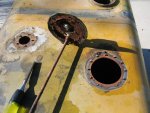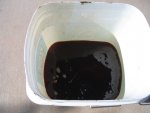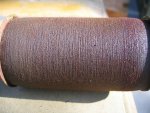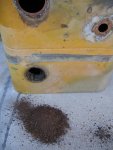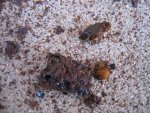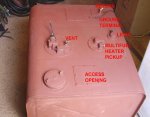JDToumanian
Active member
- 1,655
- 14
- 38
- Location
- Phelan, CA
Hi Group,
I've been working on getting my V-18A/MTQ running, it has not run since I bought it 2 years ago or for several years before that. The previous thread about it is here:
http://www.steelsoldiers.com/deuce/8367-1952-studebaker-v18a-mtq.html
The previous owners told me it had "fuel system problems".... The carburetor and governor have now been overhauled, and the auxiliary governor is currently being overhauled....
So I decided to get to work on the fuel tank. I knew it was going to be bad when I removed the drain plug and nothing came out! There was over an inch of sludgy old varnish in there... I had to poke a hole through the cake of crud to get the remaining liquid varnish to drain out. It would not even burn! I had to add some oil to it to burn it off.
Then I chiseled off the screw heads holding the fuel pickup and sender. Later, using heat, I was able to grab the remaining studs with Vise Grips and get them all out cleanly.
The fuel pickup was so bad I couldn't believe it... I don't know if the pics show how bad it was, but the porous filter was completely plugged - you could not blow through it. The pickup tube was also completely blocked. I got NOS replacements for these parts, and a new sender as well.
I let the tank air dry for a few days before cleaning it out. I discovered that by pounding the sheet metal tank with my fist the varnish crumbled off, and I reached in and scooped it out... Piles of it!!! It looks like rust in the pic, and there is indeed some surface rust, but most of it is thick dried varnish that looks like black volcanic glass.
The inside of the tank actually doesn't look too bad, so I have decided not to treat it with anything. I rinsed it out with water and let it dry in the desert heat for a few hours. Then I poured in a few gallons of paint thinner and sloshed it around for a while, and drained it again. I plan to keep the tank filled to keep water out, and some additives - a little 2-stroke oil and some Sta-Bil - should keep the gas and the tank in good shape.
Jon
I've been working on getting my V-18A/MTQ running, it has not run since I bought it 2 years ago or for several years before that. The previous thread about it is here:
http://www.steelsoldiers.com/deuce/8367-1952-studebaker-v18a-mtq.html
The previous owners told me it had "fuel system problems".... The carburetor and governor have now been overhauled, and the auxiliary governor is currently being overhauled....
So I decided to get to work on the fuel tank. I knew it was going to be bad when I removed the drain plug and nothing came out! There was over an inch of sludgy old varnish in there... I had to poke a hole through the cake of crud to get the remaining liquid varnish to drain out. It would not even burn! I had to add some oil to it to burn it off.
Then I chiseled off the screw heads holding the fuel pickup and sender. Later, using heat, I was able to grab the remaining studs with Vise Grips and get them all out cleanly.
The fuel pickup was so bad I couldn't believe it... I don't know if the pics show how bad it was, but the porous filter was completely plugged - you could not blow through it. The pickup tube was also completely blocked. I got NOS replacements for these parts, and a new sender as well.
I let the tank air dry for a few days before cleaning it out. I discovered that by pounding the sheet metal tank with my fist the varnish crumbled off, and I reached in and scooped it out... Piles of it!!! It looks like rust in the pic, and there is indeed some surface rust, but most of it is thick dried varnish that looks like black volcanic glass.
The inside of the tank actually doesn't look too bad, so I have decided not to treat it with anything. I rinsed it out with water and let it dry in the desert heat for a few hours. Then I poured in a few gallons of paint thinner and sloshed it around for a while, and drained it again. I plan to keep the tank filled to keep water out, and some additives - a little 2-stroke oil and some Sta-Bil - should keep the gas and the tank in good shape.
Jon
Attachments
-
71.9 KB Views: 28
-
78 KB Views: 27
-
101.4 KB Views: 28
-
69.6 KB Views: 28
-
102.4 KB Views: 32




